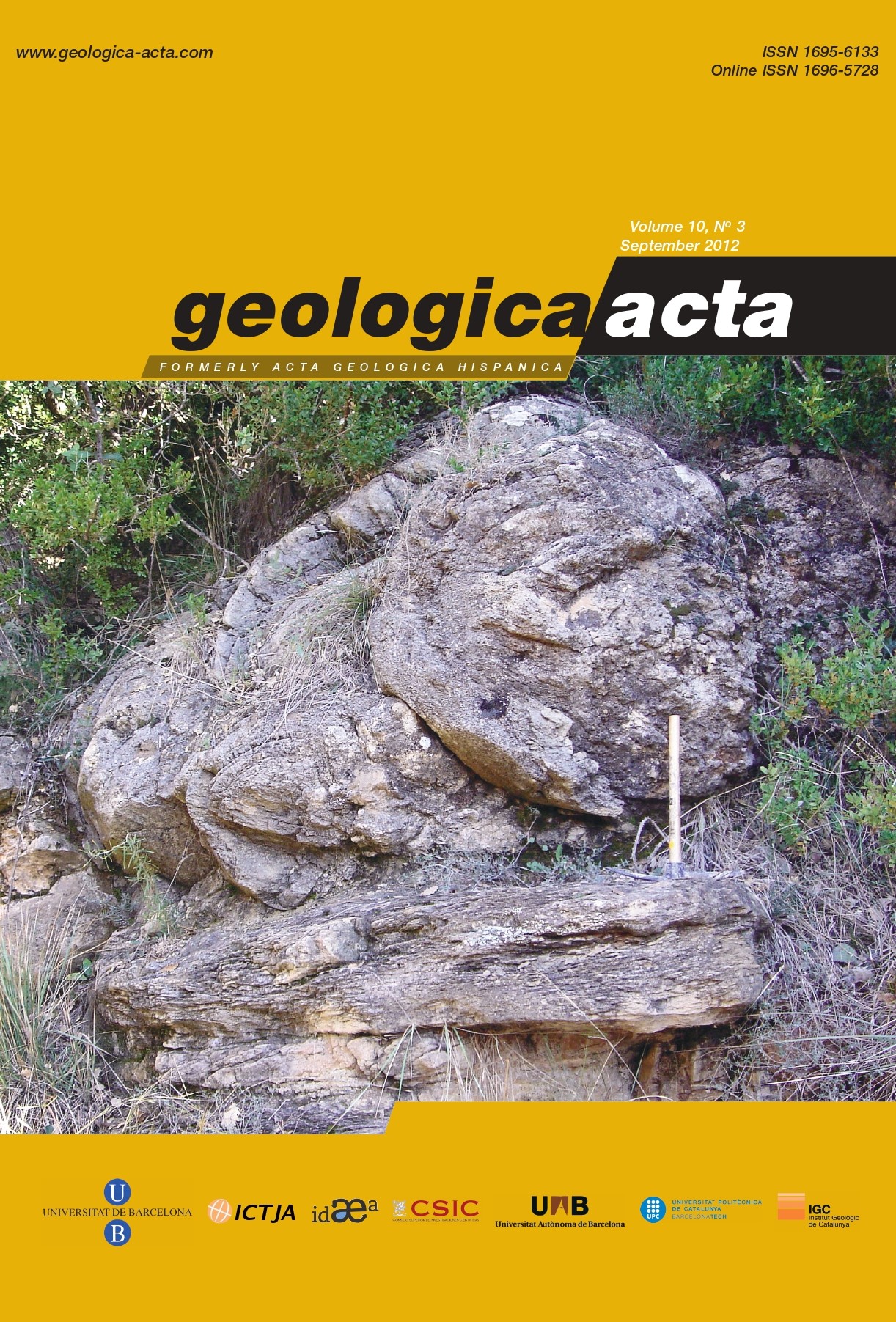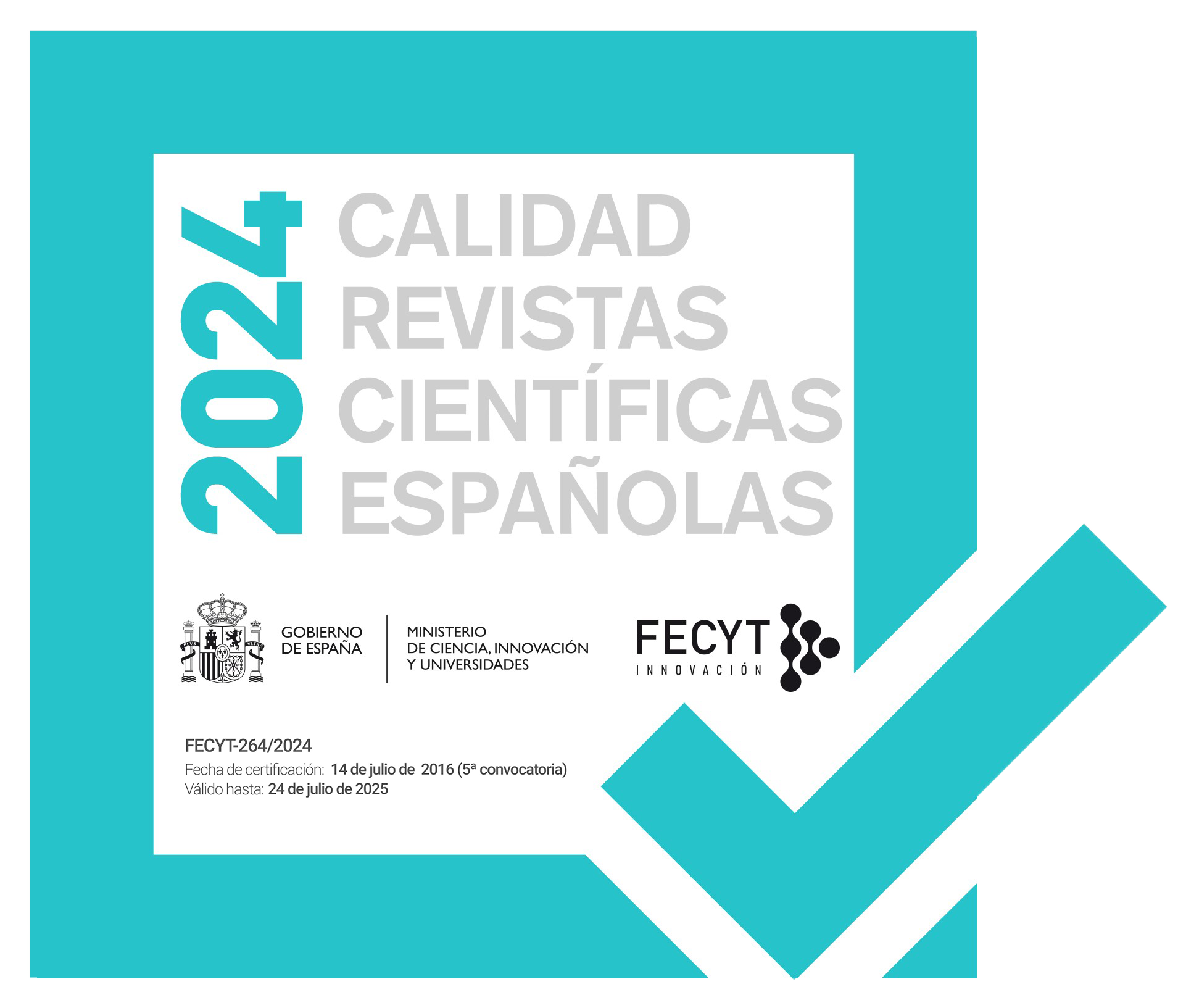Trace element analyses indicative of paleodiets in Middle Miocene mammals from the Somosaguas site (Madrid, Spain)
DOI:
https://doi.org/10.1344/105.000001746Keywords:
Geochemistry, Tooth enamel, Diagenesis, Paleoecology, HerbivoresAbstract
Trace element analysis of fossil bone and enamel constitutes a useful tool to characterize the paleoecological behavior of mammals. Up to now, most trace element studies have focused on Plio-Pleistocene fossils. Here, we show that paleodietary inferences based on trace element analyses can be also obtained from ~14Ma old Miocene mammals, in a period of time when important paleoclimatic changes took place due to the development of the East Antarctic ice sheet. Trace element ratio (Ba/Ca, Sr/Ca) analyses have been performed on herbivore tooth enamel (gomphothere Gomphotherium angustidens, equid Anchitherium cf. A. cursor, suid Conohyus simorrensis and ruminants) across three stratigraphic levels from the Somosaguas site (Middle Miocene, Madrid Basin, Spain). Previous scanning electron microscope, rare earth element and stable isotope analyses suggested minimal diagenetic alteration of the tooth enamel samples. Trace element analyses reported here show different paleoecological behavior among the studied fossil taxa. Anchitherium cf. A. cursor shows higher Ba/Ca and Sr/Ca ratios than Gomphotherium angustidens, indicating the equid was a mixed-feeder, while the gomphothere was a browser. The enrichment in Ba/Ca and Sr/Ca ratios in the ruminants is attributed to differences in their gastrointestinal tracts and to a more grazing diet. A high variability in trace element values characterizes the suid Conohyus simorrensis, which is believed to be connected to some degree of omnivory.
References
Ayliffe, L.K., Chivas, A.R., Leakey, M.G., 1994. The retention of primary oxygen isotope compositions of fossil elephant skeletal phosphate. Geochimica et Cosmochimica Acta, 58, 5291-5298.
Balter, V., Lécuyer, C., 2004. Determination of Sr and Ba partition coefficients between apatite and water from 5ºC to 60ºC: A potential new thermomether for aquatic paleoenvironments. Geochimica et Cosmochimica Acta, 68, 423-432.
Balter ,V., Bocherens, H., Person, A., Labourdette, N., Renard, M., Vandermeersch, B., 2002. Ecological and physiological variability of Sr/Ca and Ba/Ca in mammals of West European mid-Würmian food webs. Palaeogeography, Palaeoclimatology, Palaeoecology, 186, 127-143.
Blum, J.D., Taliaferro, H., Weisse, M.T., Holmes, R.T., 2000. Changes in Sr/Ca, Ba/Ca and 87Sr/86Sr ratios between trophic levels in two forest ecosystems in the northeastern USA. Biogeochemistry, 49, 87-101.
Botha, J., Lee-Thorp, J., Chinsamy, A., 2005. The palaeoecology of the non-mammalian cynodonts Diademodon and Cynognathus from the Karoo Basin of South Africa, using stable light isotope analysis. Palaeogeography, Palaeoclimatology, Palaeoecology, 223, 303-316.
Bowen, H.J.M., Dymond, J.A., 1955. Strontium and barium in plants and soils. Proceedings of the Royal Society of London, 144(B), 355-368.
Bryant, J.D., Koch, P.L., Froelich, P.N., Showers, W.J., Genna, B.J., 1996. Oxygen isotope partitioning between phosphate and carbonate in mammalian apatite. Geochimica et Cosmochimica Acta, 60, 5145-5148.
Burton, J.H., Price, T.D., Middleton, W.D., 1999. Correlation of bone Ba/Ca and Sr/Ca due to biological purification of calcium. Journal of Archaeological Science, 26, 609-616.
Calvo, J.P., 1989. Terciario. In: Pérez-González, A., Calvo, J.P. (eds.). Memoria de la Hoja Geológica 1:50.000, Madrid, No 559. Madrid, Instituto Geológico y Minero de España (IGME), 9-45.
Carrasco, A., Sacristán, S., Benítez-López, G., Romero-Nieto, D., Fesharaki, O., López-Martínez, N., 2008. Estudio mineralógico del yacimiento de vertebrados miocenos de Somosaguas: aplicaciones paleoclimáticas y paleoambientales. Paleontologica Nova. Seminarios de Paleontología de Zaragoza, 8, 135-149.
Cuevas-González, J., 2006. Estudio isotópico de δ13C y δ18O en sedimentos y fósiles de los yacimientos de Somosaguas del Mioceno Medio (Cuenca de Madrid). Madrid, Trabajo de investigación para la obtención del Diploma de Estudios Avanzados (DEA), Universidad Complutense de Madrid, 31pp.
Cuevas-González, J., Elez, J., 2006. Arquitectura deposicional en un depósito aluvial basada en la distribución de fósiles de vertebrados del Mioceno de Somosaguas. Madrid, XXII Jornadas de la Sociedad Española de Paleontología, Libro de Resúmenes, 110-111.
Daams, R., Freudenthal, M., Van De Weerd, A., 1977. Aragonian, a new stage for continental deposits of Miocene age. Newsletters on Stratigraphy, 6, 42-55.
Domingo, L., Cuevas-González, J., Grimes, S.T., Hernández Fernández, M., López-Martínez, N., 2009. Multiproxy reconstruction of the palaeoclimate and palaeoenvironment of the Middle Miocene Somosaguas site (Madrid, Spain) using herbivore dental enamel. Palaeogeography, Palaeoclimatology, Palaeoecology, 272, 53-68.
Eberle, J., Sponheimer, M., Marchitto, T., 2009. Biogenic patterning of Sr and Ba in Early Oligocene (Orellan) mammalian tooth enamel. Journal of Vertebrate Paleontology, 29, 91A.
Elez, J., 2005. Aplicación GIS 3D a los yacimientos paleontológicos de Somosaguas. Trabajo de investigación para la obtención del Diploma de Estudios Avanzados (DEA), Madrid, Universidad Complutense de Madrid, 39pp.
Elias, R.W., Hirao, Y., Patterson, C.C., 1982. The circumvention of the natural biopurification of calcium along nutrient pathways by atmospheric inputs of industrial lead. Geochimica et Cosmochimica Acta, 46, 2561-2580.
Fricke, H.C., Rogers, R.R., Backlund, R., Dwyer, C.N., Echt, S., 2008. Preservation of primary stable isotope signals in dinosaur remains, and environmental gradients of the Late Cretaceous of Montana and Alberta. Palaeogeography, Palaeoclimatology, Palaeoecology, 266, 13-27.
Gilbert, C., Sealy, J., Sillen, A., 1994. An investigation of barium, calcium and strontium as palaeodietary indicators in the Southwestern Cape, South Africa. Journal of Archaeological Science, 21, 173-184.
Hernández Fernández, M., Cárdaba, J.A., Cuevas-González, J., Fesharaki, O., Salesa, M.J., Corrales, B., Domingo, L., Elez, J., López Guerrero, P., Sala-Burgos, N., Morales, J., López Martínez, N., 2006. Los yacimientos de vertebrados del Mioceno medio de Somosaguas (Pozuelo de Alarcón, Madrid): implicaciones paleoambientales y paleoclimáticas. Estudios Geológicos, 62, 263-294.
Hernández Fernández, M., Alcalde, G., DeMiguel, D., García Yelo, B., Azanza, B., 2009. Functional groups in ruminants as environmental proxies. Journal of Vertebrate Paleontology, 29(3), 113A.
Hoppe, K.A., Koch, P.L., Furutani, T.T., 2003. Assessing the preservation of biogenic strontium in fossil bones and tooth enamel. International Journal of Osteoarchaeology, 13, 20-28.
Iacumin, P., Bocherens, H., Mariotti, A., Longinelli, A., 1996. Oxygen isotope analyses of co-existing carbonate and phosphate in biogenic apatite: a way to monitor diagenetic alteration of bone phosphate? Earth and Planetary Science Letters, 142, 1-6.
Kaiser, T.M., 2009. Anchitherium aurelianense (Equidae, Mammalia): a brachydont “dirty browser” in the community of herbivorous large mammals from Sandelzhausen (Miocene, Germany). Paläontologische Zeitschrift, 83, 131-140.
Kolodny, Y., Luz, B., 1991. Oxygen isotopes in phosphates of fossil fish- Devonian to Recent. In: Taylor, H.P., O’Neil, J.R., Kaplan, I.R. (eds.). Stable Isotope Geochemistry: A Tribute to Samuel Epstein. The Geochemical Society, 3 (Special Publications), 105-119.
Lécuyer, C., Bogey, C., Garcia, J.P., Grandjean, P., Barrat, J.A., Floquet, M., Bardet, N., Pereda-Suberbiola, X., 2003. Stable isotope composition and rare earth element content of vertebrate remains from the Late Cretaceous of northern Spain (Laño): did the environmental record survive? Palaeogeography, Palaeoclimatology, Palaeoecology, 193, 457-471.
Lee-Thorp, J.A., Sponheimer, M., 2003. Three case studies used to reassess the reliability of fossil bone and enamel isotope signals for paleodietary studies. Journal of Anthropological Archaeology, 22, 208-216.
Lee-Thorp, J.A., Van der Merwe, N.J., 1987. Carbon isotope analysis of fossil bone apatite. South African Journal of Science, 83, 712-715.
Lee-Thorp, J.A., Van der Merwe, N.J., 1991. Aspects of the chemistry of modern and fossil biological apatites. Journal of Archaeological Science, 18, 343-354.
López Martínez, N., Elez Villar, J., Hernando Hernando, J.M., Luis Cavia, A., Mazo, A., Minguéz Gandú, D., Morales, J., Polonio Martín, I., Salesa, M.J., Sánchez, I.M., 2000. Los fósiles de vertebrados de Somosaguas (Pozuelo, Madrid). Coloquios de Paleontología, 51, 69-85.
Luís, A., Hernando, J.M., 2000. Los microvertebrados fósiles del Mioceno Medio de Somosaguas Sur (Pozuelo de Alarcón, Madrid, España). Coloquios de Paleontología, 51, 87-136.
Martin, J.E., Patrick, D., Kihm, A.J., Foit, F.F., Grandstaff, D.E., 2005. Lithostratigraphy, tephrochronology, and rare earth element geochemistry of fossils at the classical Pleistocene
fossil lake area, South Central Oregon. Journal of Geology, 113, 139-155.
Metzger, C.A., Terry, Jr.D.O., Grandstaff, D.E., 2004. Effect of paleosol formation on rare earth element signatures in fossil bone. Geology, 32, 497-500.
Mínguez-Gandú, D., 2000. Marco estratigráfico y sedimentológico de los yacimientos paleontológicos miocenos de Somosaguas (Madrid, España). Coloquios de Paleontología, 51, 183-195.
Nedin, C., 1991. The dietary niche of the extinct Australian marsupial lion: Thylacoleo carnifex Owen. Lethaia, 24, 115-118.
Palmqvist, P., Gröcke, D.R., Arribas, A., Fariña, R.A., 2003. Paleoecological reconstruction of a lower Pleistocene large mammal community using biogeochemical (d13C, d15N, d18O, Sr:Zn) and ecomorphological approaches. Paleobiology, 29, 205-229.
Perales, R., Serrano, H., García Yelo, B.A., Hernández Fernández, M., 2009. Inferencias paleoambientales del Mioceno Medio de Somosaguas (Pozuelo de Alarcón, Madrid) basadas en la estructura de tamaños corporales de su fauna de mamíferos. Paleolusitana, 1, 317-325.
Reynard, B., Lécuyer, C., Grandjean, P., 1999. Crystal-chemical controls on rare earth element concentrations in fossil biogenic apatites and implications for paleoenvironmental reconstructions. Chemical Geology, 155, 233-241.
Runia, L.T., 1987. Strontium and calcium distribution in plants: Effect on palaeodietary studies. Journal of Archaeological Science, 14, 599-608.
Safont, S., Malgosa, A., Subirà, M.E., Gibert, J., 1998. Can trace elements in fossils provide information about palaeodiet? International Journal of Osteoarchaeology, 8, 23-37.
Salesa, M.J., Sánchez, I.M., 2000. Estudio de los restos de Anchitherium Meyer, 1834 (Equidae; Perissodactyla) del yacimiento de Somosaguas (Pozuelo de Alarcón, Madrid). Coloquios de Paleontología, 51, 197-212.
Sánchez, I.M., 2000. Rumiantes Mammalia, Artiodactyla del yacimiento de Somosaguas Aragoniense Medio, Madrid, España. Coloquios de Paleontología, 51, 223-234.
Sánchez, I.M., Morales, J., 2006. Distribución biocronológica de los Moschidae (Mammalia, Ruminantia) en España. Estudios Geológicos, 62, 533-546.
Sillen, A., 1986. Biogenic and diagenetic Sr/Ca in Plio-Pleistocene fossils of the Omo Shungura Formation. Paleobiology, 12, 311-323.
Sillen, A., 1992. Strontium-calcium ratios (Sr/Ca) of Australopithecus robustus and associated fauna from Swartkrans. Journal of Human Evolution, 23, 495-516.
Sillen, A., Kavanagh, M., 1982. Strontium and paleodietary research: A review. Yearbook of Physical Anthropology, 25, 67-90.
Sinclair, A.R.E., 2000. Adaptation, niche partitioning, and coexistence of African bovidae: clues to the past. In: Vrba, E.S., Schaller, G.B. (eds.). Antelopes, deer, and relatives. New Haven, Yale University Press, 247-260.
Sponheimer, M., Lee-Thorp, J.A., 1999. Alteration of enamel carbonate environments during fossilization. Journal of Archaeological Science, 26, 143-150.
Sponheimer, M., Lee-Thorp, J.A., 2006. Enamel diagenesis at South African Australopith sites: Implications for paleoecological reconstruction with trace elements. Geochimica et Cosmochimica Acta, 70, 1644-1654.
Sponheimer, M., de Ruiter, D., Lee-Thorp, J., Späth, A., 2005. Sr/Ca and early hominin diets revisited: new data from modern and fossil tooth enamel. Journal of Human Evolution, 48, 147-156.
Toots, H., Voorhies, M.R., 1965. Strontium in fossil bones and the reconstruction of food chains. Science, 149, 854-855.
Trueman, C.N., Benton, M.J., 1997. A geochemical method to trace the taphonomic history of reworked bones in sedimentary settings. Geology, 25, 263-266.
Tütken, T., Vennemann, T., 2009. Stable isotope ecology of Miocene large mammals from Sandelzhausen, southern Germany. Paläontologische Zeitschrift, 83, 207-226.
Tütken, T., Vennemann, T.W., Pfretzschner, H.U., 2008. Early diagenesis of bone and tooth apatite in fluvial and marine settings: Constraints from combined oxygen isotope, nitrogen and REE analysis. Palaeogeography, Palaeoclimatology, Palaeoecology, 266, 254-268.
Wallace, A., Romney, E.M., 1971. Some interactions of Ca, Sr, and Ba in plants. Agronomy Journal, 63, 245-248.
Wang, Y., Cerling, T.E., 1994. A model of fossil tooth and bone diagenesis: implications for paleodiet reconstruction from stable isotopes. Palaeogeography, Palaeoclimatology, Palaeoecology, 107, 281-289.
Downloads
Published
Issue
Section
License

This work is licensed under a Creative Commons Attribution-ShareAlike 4.0 International License.
Copyright
Geologica Acta is the property of the UB, GEO3BCN, IDAEA and UAB. Geologica Acta must be cited for any partial or full reproduction. Papers are distributed under the Attribution-Share Alike Creative Commons License. This license allows anyone to reproduce and disseminate the content of the journal and even make derivative works crediting authorship and provenance and distributing possible derivative works under the same or an equivalent license.
Author Rights
Authors retain the copyright on their papers and are authorized to post them on their own web pages or institutional repositories. The copyright was retained by the journal from the year 2003 until 2009. In all cases, the complete citation and a link to the Digital Object Identifier (DOI) of the article must be included.
The authors can use excerpts or reproduce illustrations of their papers in other works without prior permission from Geologica Acta provided the source of the paper including the complete citation is fully acknowledged.




